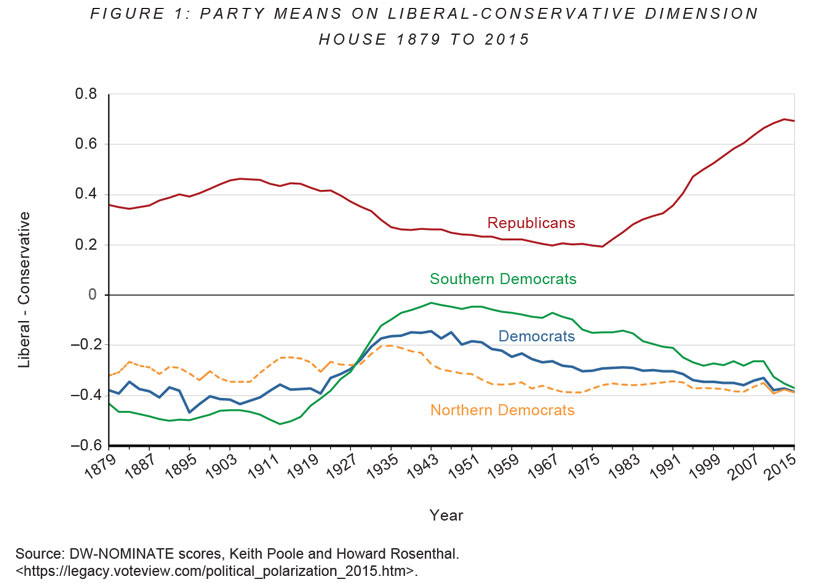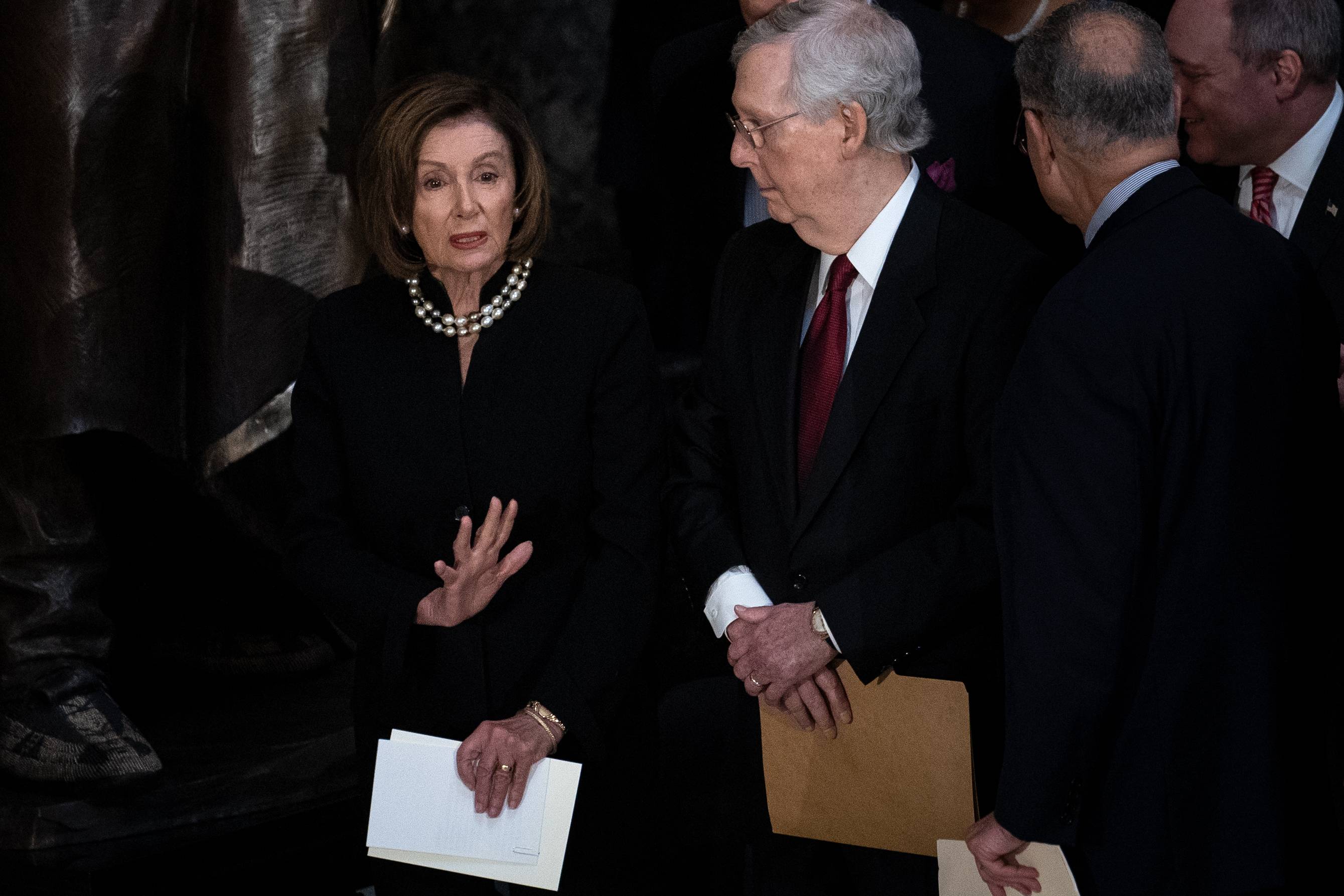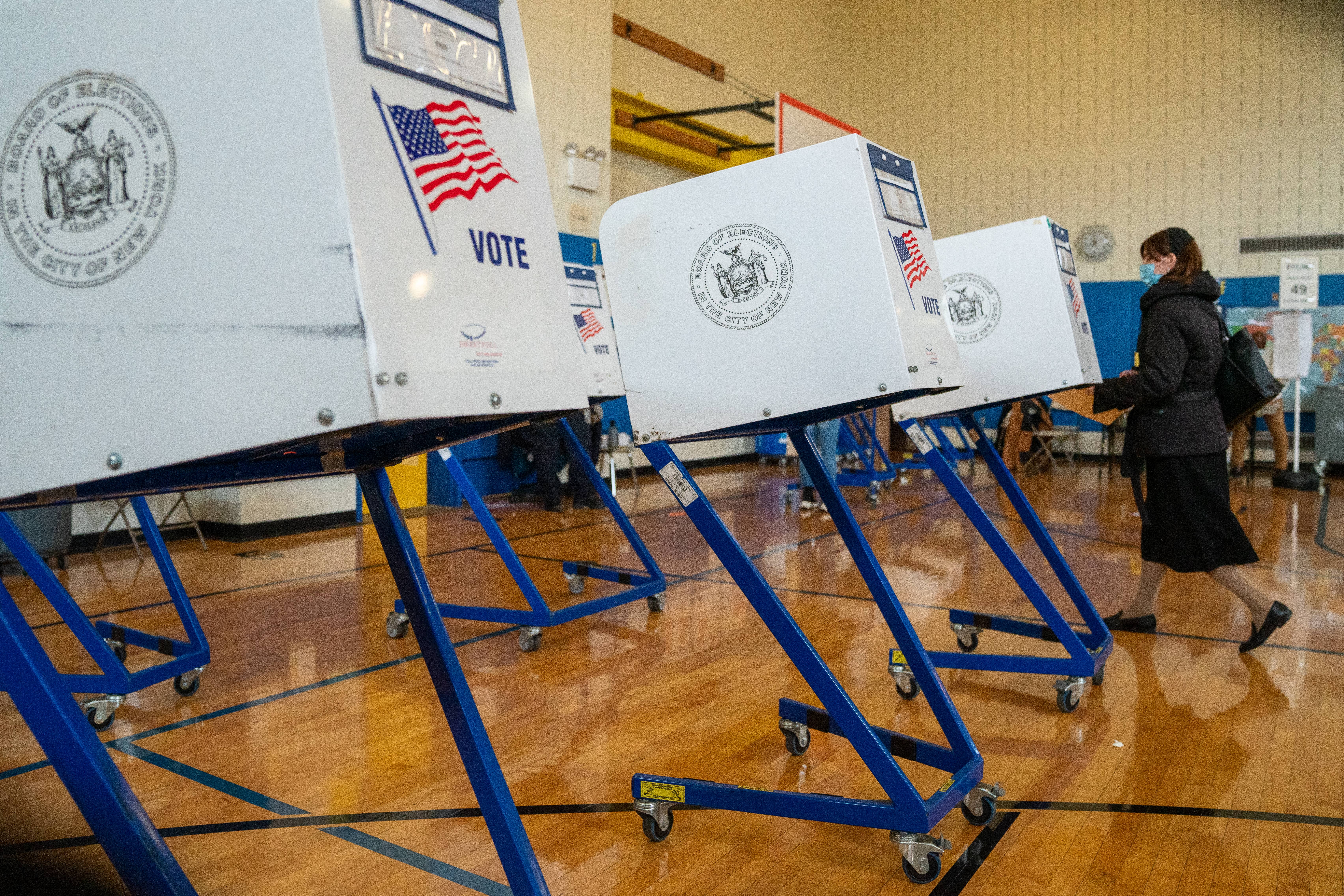The Mismeasurement of Polarization
There is little doubt that America has become more polarized in recent decades. Growing numbers of Americans say that they fear the other party, that they would not want their children to marry members of the other party, and that they believe the opposing party poses a threat to the nation. This polarization relates to what political scientists call the "sorting" of both parties into clear ideological groups, with liberals identifying more consistently as Democrats and conservatives as Republicans.
There is also broad agreement among the intelligentsia that our polarization has been asymmetric — that while Democrats have moved somewhat leftward over the past 40 years, Republicans have moved far more sharply to the right. If this is true, then much of the talk about a failure to compromise is a false equivalence; what lies at the root of polarization's ills is an increasingly conservative Republican Party.
While some aspects of the asymmetric-polarization story are true, it often fails to answer, or even ask, a key question: How do politics change when policies do?
If polarization is not just about people's feelings toward the other party, or about the rhetoric and procedural moves each party uses, but about the ultimate changes in public policy that each party implements, looking at measures of ideology in a vacuum will tell us little. To understand what ideological polarization means and how it has changed over time, we need to put such measures in the context of shifts in policy and public opinion.
The interaction of politics, policy, and public opinion should change how we look at polarization. In one sense, some conservative Republicans have indeed moved away from what we now consider the center. But the center itself has also changed, and veered emphatically to the left. Both parties, to varying degrees, have followed this shift over time. The changing context helps explain why each party can see the other as "radical" relative to what it considers the center, and why the argument that the right has moved rightward more than the left has moved leftward is unpersuasive.
MEASURING IDEOLOGY
For most of American history, it was difficult to say what it meant to be a "liberal" or a "conservative," or to be on the political "right" or "left." In fact, until the early 20th century, most politicians did not use these terms. Even when they began to sort into self-defined liberal and conservative camps, deciding which politician was liberal or conservative was often more a matter of taste than ideology.
Beginning in the late 1940s with Americans for Democratic Action (an organization created by Democrats like Eleanor Roosevelt), interest groups began "scoring" members of Congress based on their votes. These scores usually ranged from 100, indicating that the member always voted as the group wanted, to 0, indicating that he never voted as the group wanted. Such scoring became a handy way for voters to identify like-minded politicians, as well as a way for researchers to sort politicians along a simple left-right spectrum.
In the 1980s, professors Keith Poole and Howard Rosenthal, then both of Carnegie Mellon University, took an enormous step forward in the measurement of political polarization. With funding from the National Science Foundation, they created a database of every recorded vote in the history of the U.S. Congress. Poole and Rosenthal, whose names would soon appear in thousands of academic articles, then scored these votes on a conservative-to-liberal axis and used these "NOMINATE" scores, as they became known, to rank members of the same Congress.
But Poole and Rosenthal still had no way to measure the relative conservative or liberal leaning of politicians across time. To accomplish this, they combined two ideas to find a single score for every individual who had served in Congress, going all the way back to 1789.
First, they embraced the political-science truism that politicians "die in their ideological boots" — in other words, members refuse to change their core voting tendencies despite shifts in public preferences. Although Poole and Rosenthal allowed for some shifts in individual members' preferences over time, the substance of their spatial voting model, as well as its results, focused on comparing scores under the assumption that members' voting remains ideologically consistent over time.
They then compared the ideologies of each member of Congress with "bridge" members — those who served through the beginning or end of a given member's career. To illustrate the technique, imagine that Senator Kay Bailey Hutchison, a Republican from Texas, voted 80% of the time with Senator Orrin Hatch, a conservative Republican from Utah. Now suppose Hutchison was replaced by Senator Ted Cruz, who voted 90% of the time with Hatch. In such a scenario, Cruz would be rated as more conservative than Hutchison even if the two never served at the same time. Poole and Rosenthal made similar comparisons for almost all of the 12,000-plus members of Congress. Thus was born the Dynamic Weighted (or "DW") NOMINATE score. This cross-time comparison was a first for American political science.
Breaking down DW-NOMINATE scores by party over time produces a picture of partisan polarization that feeds a narrative now commonly accepted in academia and the press. During the late 19th century, as this story would have it, the two parties were about as far apart as they could be, with Republicans consistently voting conservative and Democrats consistently voting liberal. Through the middle of the 20th century, both parties — led especially by conservative Southern Democrats — tended to move toward the center. Between the 1930s and the late 1970s, the two parties were barely distinguishable. Then from the 1980s onward, both became more ideological again, led by an increasingly conservative Republican Party.
These scores, and the hundreds of political-science papers based on them, undergird the popular narrative on party polarization. Its conclusion is straightforward: Our politics is divided now because the Republican Party has moved sharply to the right.
THE SHIFTING CENTER
But when we dig into this story a bit more, we discover some curious complications.
For instance, according to Poole and Rosenthal, the Democratic Party was more liberal in the late 19th century than it would ever be again. But based on what we know of history, this is plainly not true. When Democrats achieved power under President Grover Cleveland, federal spending rarely rose above 2% of GDP. The party used its power to focus on cutting tariffs. The only significant regulatory measure advanced then, the Interstate Commerce Act of 1887, gave the government investigative powers over railroads. Indeed, modern histories of the period frequently argue that the Democrats, with their low tax and tariff polices, their thirst for localism and government retrenchment, and their general anti-civil rights stance, were something like the conservatives of that era, while the pro-tariff, pension-granting, subsidy-bestowing Republicans were the more liberal party.

Democrats and Republicans did often vote in lockstep with their fellow partisans during the late 19th century, as the regular NOMINATE scores show. But as Princeton's Frances Lee demonstrates in a recent article published in Studies in American Political Development, most of those votes were on issues of patronage, logrolling, and distribution of money to allies — matters we would not consider linked to ideology. As such, the extreme party polarization of the period represented not the presence, but the absence of ideological divides.
The disparity between the narrative and the history remains just as stark in the decades that followed. During the early 20th century, according to DW-NOMINATE, both the Democratic and the Republican parties moved toward the middle. Yet these years marked the beginning of the Progressive Era, which led to the creation of, among other things, a federal income tax, the Food and Drug Administration, the Federal Reserve, and the Federal Trade Commission, along with a host of interventionist programs almost unthinkable to the small-government parties of the 19th century. Democrats' shift to the center, as the figure shows, was especially rapid during the 1930s, when President Franklin Roosevelt's New Deal permanently reshaped American government in what any observer would describe as a leftward direction. This was not a moderate era by any measure — except for DW-NOMINATE.
Scoring and history also diverge in recent decades. For instance, in 2007, Poole and Rosenthal used their system to assert that "in the early years of the twenty-first century, the Republicans in Congress are as conservative as they were at the beginning of the twentieth century." But at the time, Republicans (who had control of the White House, the House of Representatives, and, for much of the period, the Senate) oversaw a government that spent almost 20% of GDP. By contrast, during the early 20th century — when DW-NOMINATE shows the Republican Party to have been at its most conservative before George W. Bush's presidency — the government accounted for just 2% of GDP.
On the whole, it's hard to escape the impression that, with a few minor exceptions and temporary deviations, the American public-policy landscape has shifted sharply to the left over the past century and a half. Although there have been sporadic attempts to cut spending or roll back selected areas and authorities, the federal government has exploded in size. Between 1960 and today, the share of GDP devoted to entitlements more than doubled, from 6% to 13%. The one sector of public spending conservatives tend to support — the military — accounted for over 50% of federal expenditures and around 10% of GDP in the 1950s; today, it accounts for less than 20% of federal expenditures and about 3% of GDP. Programs once seen as unimaginably left-wing, like Medicare and Medicaid, have become sacrosanct for elected officials of all stripes. At the same time, liberal social transformations with policy implications (most notably gay marriage, which was not so long ago a fringe view even among progressives) are now broadly accepted. Any measure of how the parties' ideology has become more conservative or liberal over time that doesn't take these policy shifts into account is meaningless.
COMPARED TO WHAT?
Political scientists' arguments about absolute, not just relative, shifts in polarization over time rely on the idea that politicians tend to be remarkably stable in their ideological beliefs. In one sense, this is true: Poole and Rosenthal find that votes by a member of Congress can be predicted with about 85% accuracy over the course of his career.
Yet if the policy landscape changed over that period, those relatively conservative or liberal votes may not amount to ideological rigidity. It is worthwhile, therefore, to compare different politicians at different times to see how their scores compare with their politics.
The DW-NOMINATE system purports to allow users to compare the ideology of any member of Congress to that of any other member of Congress using a single score. That score ranges from -1, for the most liberal, to 1, for the most conservative. By this measure, Senator George Pendleton of Ohio, who served during the late 19th century, scored a -0.42, and was therefore one of the more liberal members of Congress in American history. He was significantly more liberal than, say, today's Senator Robert Menendez of New Jersey, who scores a -0.37.
Yet Pendleton voted against many pension bills and public-works projects — virtually the only types of government spending at the time. He was also a noted opponent of the 13th Amendment, which put an end to slavery. Menendez is a standard-issue 21st-century Democrat: He supports a host of measures — from massive expansions of federal spending to family-planning funding under Medicaid — that would have made Pendleton blanch. And presumably, Menendez is a fan of the 13th Amendment. What should be made of a metric that would put him to the right of Pendleton?
By that same measure, Senator Orrin Hatch of Utah — a Republican who served from 1977 until 2019 and was considered a conservative in his time (with a score of 0.38) — should be seen as more conservative than Senator Roscoe Conkling of New York, a Republican who scored 0.31 during his terms between the 1850s and the 1880s. Yet Hatch regularly voted for budgets that included orders of magnitude more spending than anything witnessed in the mid-19th century. He also supported the expansion and creation of vast social programs (like the 2003 prescription-drug benefit under Medicare), as well as a bill to prohibit discrimination against gay, lesbian, and transgender people in the workplace in 2013. All of this would have been inconceivable in Conkling's time.
These historical comparisons bring up a quandary: If the average new member of Congress is not much more liberal, or is even more conservative, than the member who previously held the same seat, as DW-NOMINATE suggests, how did these long-term leftward shifts in the policy landscape occur? The only reasonable explanation is that politicians do shift over time, or along with the times. In short, even if politicians are consistent in their rankings compared to other politicians in their cohort (i.e., they die in their relative ideological boots), over time, they follow the trend of public opinion. And that trend has pulled our politics decidedly to the left.
Hatch offers a good example here. His 2013 vote in favor of the anti-discrimination bill (the Employment Non-Discrimination Act), would have been positively shocking to a younger Senator Hatch in the 1970s, when the issue was so far outside the mainstream as to not even emerge for a vote in Congress. A measure of ideology, and of polarization, that views the period in which that transformation occurred as a time in which Republicans moved sharply to the right is plainly missing something.
WHAT IS A LIBERAL?
From our contemporary perspective, it's easy to say that the entire policy terrain in our country has veered leftward in many key respects. But some policy questions are more fraught, and any evaluation of them has to be measured not just with reference to changing policy baselines, but also in relation to changing social circumstances. In these areas, it is impossible to say whether our politics has moved to the left or the right, or even what "left" or "right" really mean.
For instance, there is a broad consensus that the country moved rightward on law and justice issues from the 1970s to the 1990s. Most of this shift happened at the state and local levels, but during that time, both parties at all levels of government came to support longer prison sentences, increased spending on police and corrections, and more frequent use of the death penalty. There is also a consensus that, since the mid-2000s, both parties have moved leftward again on these issues, with the Right on Crime movement allying with civil libertarians and those on the left concerned about mass incarceration as the new Jim Crow. This seeming leftward shift could even encompass the presidency of Donald Trump, who signed the First Step Act in 2018 to shorten federal prison sentences and increase eligibility for parole.
Yet any description of these trends must confront the question of the baseline against which change ought to be measured. The monumental transition from an era with approximately half a million people incarcerated (as was the case in the late 1970s) to over 2 million today means that even a staunchly liberal reformer is implicitly advocating for holding more people in prison than even the most conservative Republican of the 1970s. Should the total incarcerated be the measure of the tilt of policy? Or should it be something like the length of prison sentences for particular crimes? How should we account for differing levels of criminal activity at different times? Was the "rightward" shift a reaction to an increase in crime from the 1960s through the 1990s, which meant all parties showed a greater tolerance of crime than would have been acceptable in the 1950s? There is simply no objective answer to these questions, and therefore no way to quantify the ideological valence of various views on the issue.
Other issues, like immigration, confront us with the same dilemma. In this case, the consensus is that a general leftward tilt on immigration policy up through the end of the Cold War shifted to a general rightward tilt beginning in the 1990s. The transition from the bipartisan Immigration Reform and Control Act of 1986, which provided amnesty to illegal immigrants and was signed into law by Ronald Reagan, to the harsher Illegal Immigration and Immigrant Responsibility Act of 1996, sponsored by Republicans in Congress and signed by Bill Clinton, offers an illustrative example.
Yet shortly before Reagan entered office, the immigrant share of the U.S. population had bottomed out, at only 4.7%. Today, lawful permanent residents account for 13.7% of the population — nearly triple what it was in the 1970s. Not even the most anti-immigration politician today could get away with proposing a policy that would make America as "native-born" as it was during that decade. It doesn't make sense, therefore, to discuss the parties' support for or opposition to immigration-law liberalization without also discussing the changing scale of the immigrant population.
Some issues, like trade, defy all ideological categorization, and are hard to measure against changing economic circumstances. Despite its interventionist nature, the protective tariff was the centerpiece of the conservative-Republican program of the late 19th century; it wasn't until the 1970s that more Republicans in Congress voted in favor of free trade than Democrats. Matters on that front have shifted again since then — particularly during the Trump era. So are Republicans who criticize free trade today — with an economy that typically maintains tariffs of approximately 2%, and where around 15% of GDP comes from trade — more hostile to free trade than the great free-trader Franklin Roosevelt, who oversaw a government that maintained tariffs of about 20% and governed during a period when only 5% of the country's GDP came from trade? One could argue it both ways, but a metric that ignores the changing circumstances of either policy position would create false clarity on the issue.
POLARIZATION BEYOND POLICY
Public policy — the outcome of some of our most significant political battles — must ground any measure of the polarization (or radicalization) of the parties. Yet there are some important non-policy measures, such as rhetoric and procedural behavior, that offer vital signals about polarization as well.
President Trump's seeming lack of concern for conciliation, procedure, and political norms represents one type of polarization. For most of Trump's presidency, his approach to these matters garnered rhetorical support, or at least acquiescence, from Republican Party officials and lawmakers, even if they did not lead to shifts in policy. The change in rhetoric and tone can be described as a form of polarization, even if they were not reflected in durable practical changes.
Yet these forms of rhetorical polarization are sometimes mistaken for policy changes. Many Democrats, for instance, describe recent Republican efforts to reform state voting laws as an assault on democracy. But these proposals have to be considered against a background of changes that have made absentee voting, early voting, and registration far easier in even the most restrictive states today than they were in any state half a century ago. Measuring these moves in terms of long-term ideological trends would tell us less than understanding them in terms of norms and rhetoric would.
The vote by the majority of House Republicans, and a portion of Senate Republicans, to overturn the results of the 2020 presidential election in Pennsylvania and Arizona was surely the clearest recent example of one-party radicalization in our politics. Yet just days earlier, a large, bipartisan majority in Congress overrode Trump's veto of the Defense Authorization Act, and in December, the Republican Party sabotaged his request to increase Covid-relief stimulus checks by $1,400. Whatever the Republican Party's personal loyalty to Trump, it demonstrated little allegiance to his policy goals — which themselves were not easily placed on a right-left spectrum.
Political scientists Norman Ornstein and Thomas Mann have focused on factors like tone, respect for norms and procedures, and attitudes toward democracy in arguing that asymmetric polarization has taken place. They point to Republican procedural obstreperousness in Congress as an example, showing that although both parties increased their use of the Senate filibuster in the past 30 years, the Republicans have put more such roadblocks in the way of legislation.
Yet obstructionism, too, has to be measured against some shifting baselines. Although some cite it as an explanation for the decline in raw numbers of laws passed in recent years, others point to the fact that Congress passes more total pages of legislation today, around 6,500 pages per Congress, than the roughly 2,300 pages passed during the putatively more activist 1960s.
Of course, merely increasing Congress's output is not necessarily a move in one ideological direction or another. Thus, procedural claims of asymmetric polarization often face the same problem of defining the baseline against which changes can be considered more polarized or radical.
WHAT RADICALISM?
It has become a commonplace of political discourse among academics, pundits, and politicians to claim that one or the other party has become more extremist, or that it has taken a radical position on some particular issue. Most often, those making the charge fail to distinguish the baseline against which the other side has supposedly radicalized.
When those on the left say the right has radicalized, they tend to measure it against the perceived will of the people at the current time, or against some new status quo — such as the Affordable Care Act — that was itself considered leftward radicalism just a few years earlier. When those on the right say the left has radicalized, they tend to measure it against some point in the distant past, or against the long-standing status quo.
What both measures of party polarization fail to take into account are long-term shifts in policy and public opinion that have occurred over America's history. When we look to these changes, it becomes clear that the baseline against which partisanship is measured has not remained static; instead, it has shifted to the left. Both parties have followed this shift over time, with Democrats largely leading the way and Republicans following from the rear.
This changing baseline helps explain why both parties can plausibly claim that the other side has radicalized. For the left — whose adherents measure polarization from the baseline of current policy and opinion, which has itself moved left — Republicans may appear extremist, even if their positions have remained fixed over time. For the right — whose adherents measure polarization against policies and opinions of the distant past, which fell more to the right than they do today — Democrats have radicalized, in the sense that they have followed the shift of policy and opinion to the left of where it once was.
On the whole, American politics has moved, and continues to move, along with policies and the preferences of the American electorate. This may be cold comfort for conservatives, who have witnessed both drift decidedly to the left over the past century and a half. But it can help assuage the alarmism over one-sided polarization that has long plagued our political discourse.


